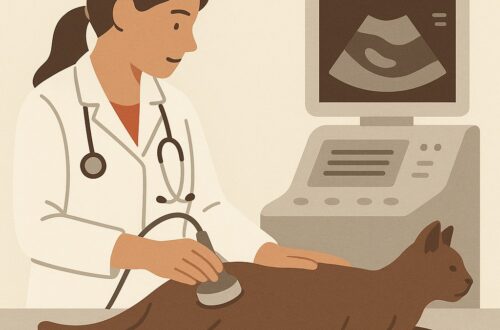One of the more profound veterinary emergencies is a uterine infection in an intact female dog. This potentially lethal problem is called a pyometra. Affected patients should receive veterinary care as quickly as possible. This week I discuss this condition in hopes of raising awareness and promoting early identification and care. Happy reading!
Pyometra – What is it?
The uterus is the organ in which fetuses grow and develop. During birth, a fetus exits the uterus through a dilated cervix into the vagina, and ultimately passes through the vulva to be delivered.

Simplistically, pyometra is an infectious and inflammatory condition of the uterus in adult, un-spayed / intact bitches (female dogs). Veterinarians do not yet fully understand the changes that lead to the development of this problem. Two major theories include:
- Ascending infection from the vagina – The vagina normally has bacteria within it. Some of these same bacteria have been cultured from the uteri of dogs with pyometra. This finding suggests this condition may occur secondary to an ascending bacterial infection. However, bacteria commonly cross the cervix from the vagina into the uterus, yet pyometra does not commonly develop.
- Changes induced by progesterone – The hormone progesterone has been implicated in the development of pyometra via several potential mechanisms. Chronic recurrent exposure of the uterine lining (called the endometrium) may cause a change to the uterine wall called cystic endometrial hyperplasia. This hormone causes glands to secrete various substances like mucus, reduces uterine contractility, induces cervical closure, and alters the immune system. These cumulative changes – called cystic endometrial hyperplasia-pyometra complex – potentially increase the likelihood of a patient developing a pyometra.
The less commonly implicated reasons for intact female dogs developing pyometra are:
- Primary urinary tract infection
- Spread of bacteria via the blood from another location in the body to the uterus
- Foreign material in the uterus
Pyometra – How is it diagnosed?
The typical patient is a middle aged or geriatric intact / un-spayed female dog. Any breed of dog may develop this condition, and some dogs appear to be predisposed, including:
- English spring spaniels
- Cavalier King Charles spaniels
- Golden retrievers
- Bernese mountain dogs
- Rough-coated collies
- Rottweilers
- Miniature Schnauzers

In contrast, some breeds have a decreased predisposition:
- Dachshunds
- German shepherds
- Swedish hounds
- Drevers
Clinical signs typically develop 1-3 months after a bitch finishes a “heat cycle (called estrus). Common, non-specific clinical signs may include:
- Lethargy & depression
- Weakness
- Reduced (or loss of) appetite
- Increased thirst & frequency of urination
- Vomiting
- Diarrhea
A veterinarian should perform a complete physical examination in any patient suspected of having a pyometra. Palpation of the abdominal cavity may identify an enlarged uterus and abdominal discomfort. Unfortunately, there is no slam-dunk physical examination finding that is 100% diagnostic for this condition. One should recall the cervix is the opening that connects the vagina and uterus. In patients with pyometra, sometimes the cervix is dilated and in others it is closed. Patients with a dilated cervix may have a vaginal/vulvar discharge visible on physical examination. Patients with “closed-cervix” pyometra are typically sicker than those with an “open-cervix.”
Blood and urine testing are recommended for patients to screen for other concurrent problems that occur in affected patients. These ailments may include dehydration, reduced blood flow to the liver, low blood sugar (hypoglycemia), and bacterial urinary tract infection. Diagnostic imaging – radiography/x-rays and sonography – can be helpful as well.
Pyometra – How is it treated?
All dogs with pyometra requires stabilization before implementing specific uterine treatment(s). Such interventions commonly include intravenous fluid therapy, supplementation of dextrose (sugar) and electrolytes (i.e.: potassium), and provision of an appropriate antibiotic. Severely affected patients can develop a systemic bacterial blood infection called sepsis. The overall mortality rate for patients with pyometra is ~5%, and most who succumb to this problem are in shock and have sepsis.
After stabilization, the treatment of choice in non-breeding dogs is ovariohysterectomy (spaying). I was trained to “never let the sun go down on a pyometra,” meaning an affected patient should have surgery as quickly as possible after stabilization. During this procedure the ovaries and uterus are surgically removed under general anesthesia. This procedure is both curative and preventive for recurrence of pyometra. Surgery is not risk-free, and serious potential complications are possible. Pet parents may choose referral to a veterinary specialty hospital where their pet can be cared for by a board-certified veterinary surgeon who has expert training in high-risk surgeries and where their fur baby may receive around-the-clock critical care directed by a board-certified veterinary emergency and care specialist.

Affected dogs may be managed without surgery if future breeding is desired and if they do not have any concurrent life-threatening complications. Patients with “closed-cervix” pyometra may have more complications during medical management. The primary goal of medical management is to reduce the effects of progesterone on the uterus. Several drugs can be used to achieve this goal, including:
- Prostaglandins (i.e.: cloprostenol, dinoprost tromethamine)
- Dopamine agonists (i.e.: cabergoline, bromocriptine)
- Progesterone receptor blockers (i.e.: aglepristone)
More recently, the technique of trans-cervical uterine flushing (called lavage) has been described in the veterinary literature. Routine performance of this procedure is not yet recommended, and it certainly should only be performed by veterinarians with expert training. Pet parents may find value in collaborating with a board-certified veterinary reproductive specialist or internal medicine specialist who have extensive experience medically managing patients with pyometra. One should not medical management can be curative, but future pyometra is possible.
The take-away message about pyometra in dogs…
Pyometra is a potentially life-threatening infection of the uterus in an intact female dog. Affected dogs may have vaginal/vulvar discharge that appears 1-3 months after a “heat” cycle, and may have non-specific signs of illness, including lethargy, weakness, lethargy, and loss of appetite. Prompt diagnosis and intervention is absolutely necessary to maximize the likelihood of a positive outcome.
To find a board-certified veterinary emergency and critical care specialist, please visit the American College of Veterinary Emergency and Critical Care.
To find a board-certified veterinary surgeon, please visit the American College of Veterinary Surgeons.
To find a board-certified veterinary reproductive specialist, please visit the American College of Theriogenology.
To find a board-certified veterinary internal medicine specialist, please visit the American College of Veterinary Internal Medicine.
Wishing you wet-nosed kisses,
cgb





